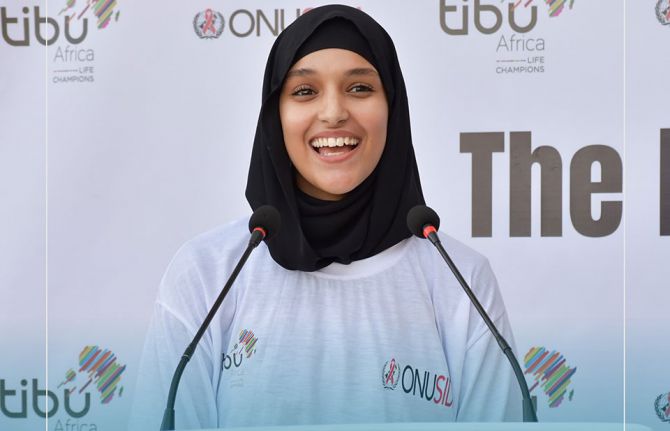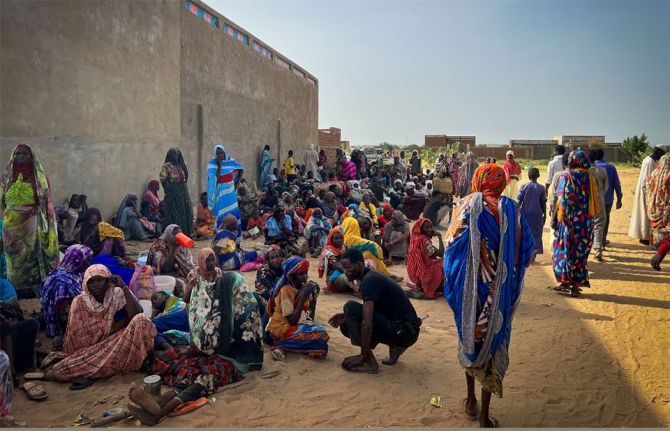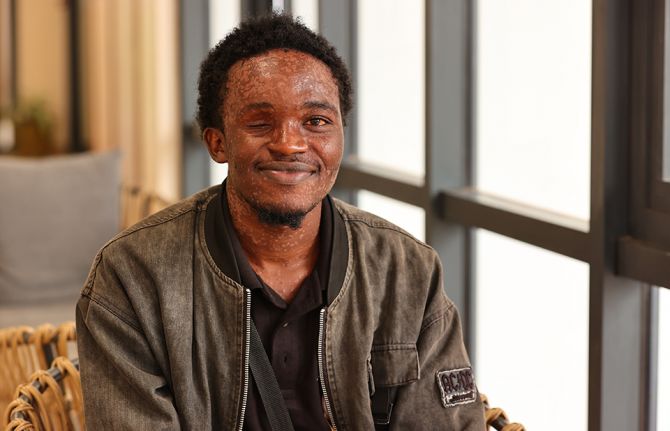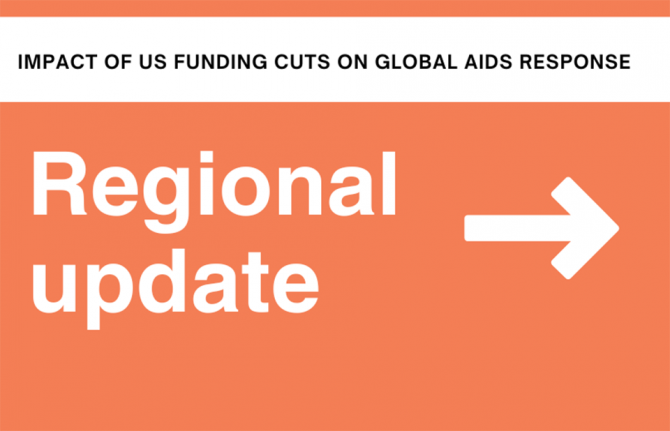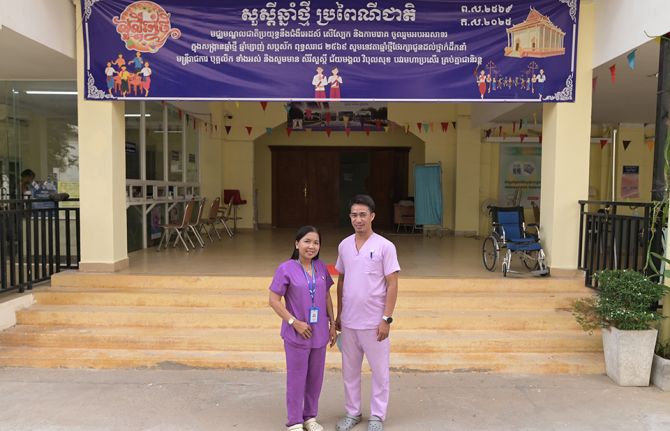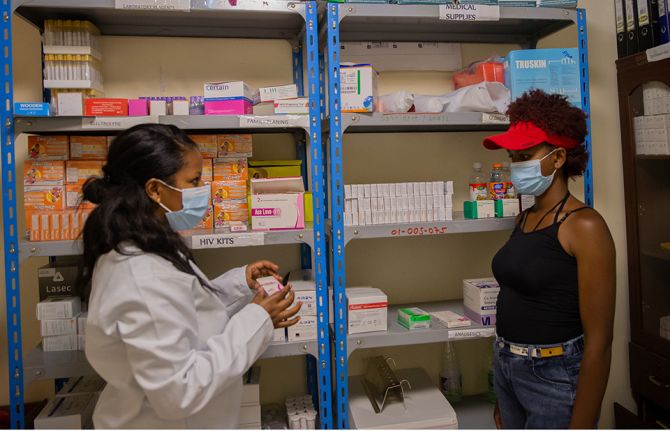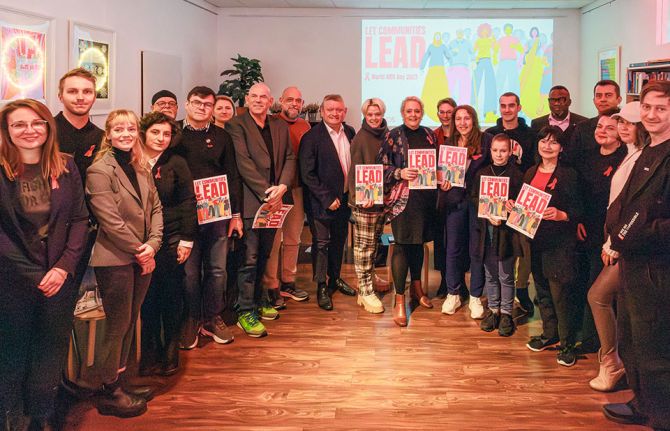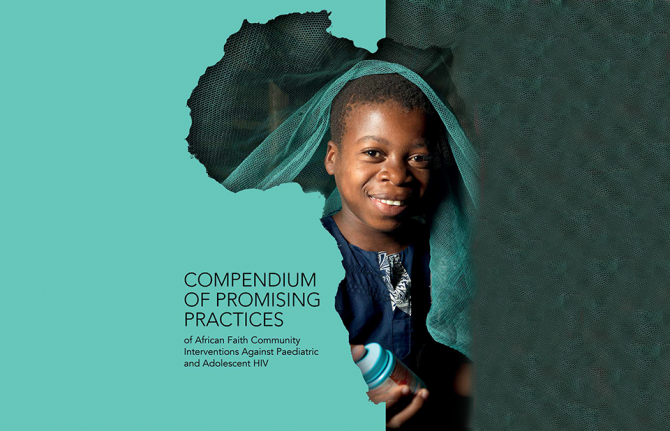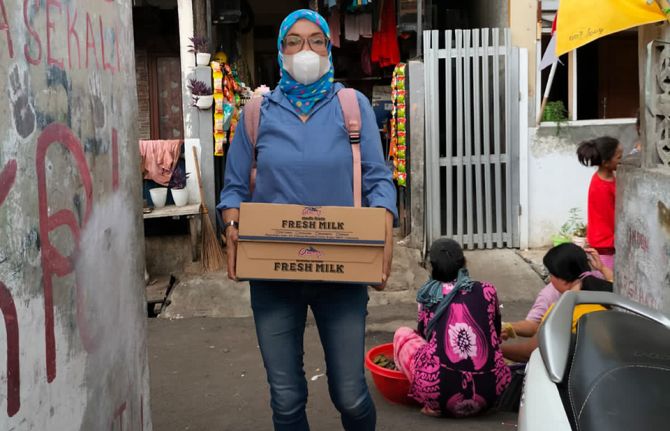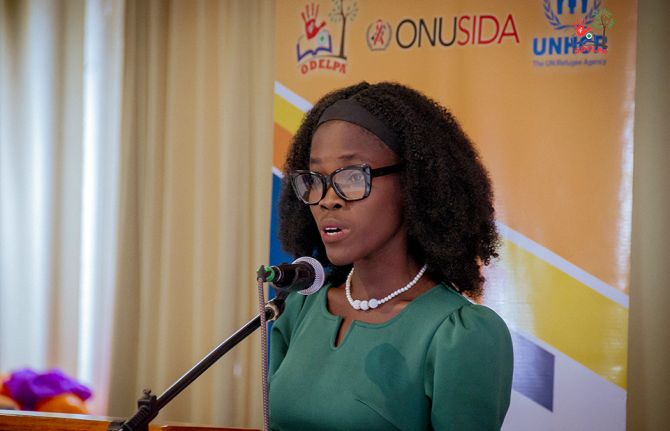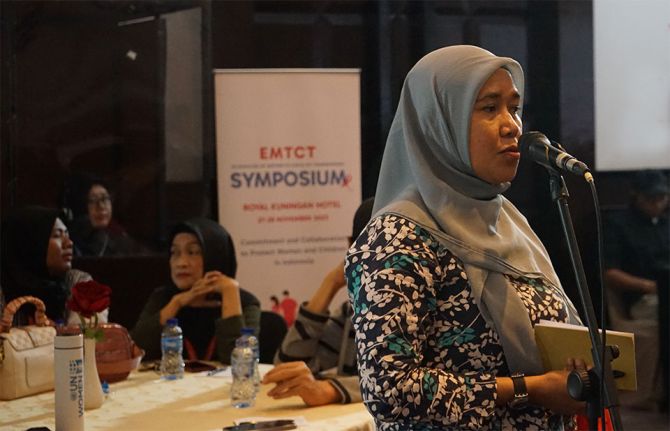
Feature Story
Hope for street children
12 January 2007
12 January 2007 12 January 2007
Dawn has just broken in Cairo, Egypt, but Ahmed is already out on the street. But unlike other children Ahmed is not on his way to school. Ahmed is 12 years old and left home when he was just six because his father in law didn’t want him in the house. After wandering from one house to another, he found that it was easier for him to live on the streets. At that time he didn’t realise that it was far more dangerous too. When the social workers of Hope Village found him, he had been beaten up, robbed many times and raped twice. Hope Village provided him with a safe place to stay and offered him much needed shelter, care and support. “We also enrolled him in an HIV session where he learned how HIV is transmitted,” said Nawara a sociologist at the Hope Village. “After what’s happened to him he is very worried that he could be positive himself,” she added.
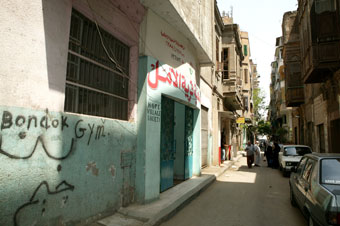
Hope Village Society was initially created to provide shelter and support to orphaned children from one of Cairo’s poorer neighbourhoods. However, a fter two years, they realized that the local street children also needed a safe place to go where they could receive care and support so they opened a day care center. The inauguration of this centre in the Shubra district of Cairo was soon followed by many others including one in the district of Sayeda Zeinab where Ahmed and other young boys come to seek refuge and comfort when the streets of Cairo become too much for them.
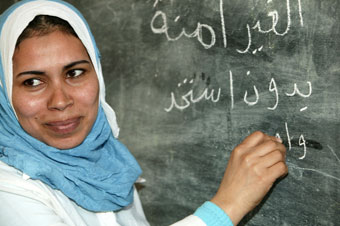
Twenty three year old Nawara has been working at Hope Village for about a year. She said that although her job is very tough it is also very rewarding, “these boys really need our help” she said. “The most difficult case I encountered, she recalled, was one of an 11 year old boy whose father threw him off the window because he was being too loud. I go with the kids when they have their medical examinations and I am shocked by what I see on their bodies–– bruises, cuts, infected wounds––It’s difficult to imagine what these kids go through,” she said.
Khalid Dawoud has been working with Hope Village for the past 17 years. He set up the Sayeda Zeinab day care centre. “I know the story inside out and I know what those kids are subjected to,” he said.
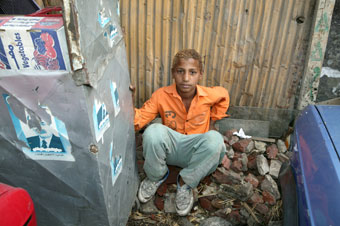
During his experience with Hope Village, Khalid noted how interested the children were in knowing more about HIV because of the dangers they face, from sexual assaults to drugs, violence and prostitution. Sex, both forced and voluntary often takes place at and other deserted places. The girls are usually more at risk because they are abused by the older street boys, by the police and others. Some girls accept to have sex for a sandwich, others do it to ensure protection in return. “It’s critical…” said Khalid “…that they know how to protect themselves from HIV. When we announced that we would open a testing centre soon, all of the kids wanted to be tested to make sure they are not infected with HIV.”
With help from UNICEF and other sponsors, the Hope Village Society undertakes a wide range of activities from providing boys and girls with care and shelter to offering them psychological support, training and behavorial skills to help them reintergrate into society.
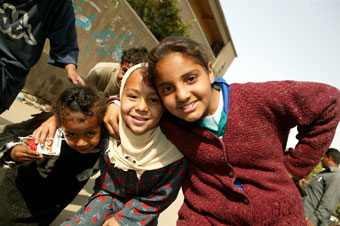
“Working with such initiatives is one of our priorities in Egypt,” said Maha Aon, UNAIDS Country Coordinator in Egypt. “We know how important and effective it is to focus interventions on people who are most likely to be exposed to HIV infection. One of the ways to protect street children is to help them understand where the risks are and how they can protect themselves in a way that they understand and which helps them care for and respect themselves.”
UNICEF, in collaboration with UNAIDS provides training on AIDS issues for the social workers at Hope Village . Nawara, who did the course in March said that the information she received and the methods of participatory teaching helped her a lot with the children. “We learned to use games to communicate information about HIV and about the dangers of life on the street, from an HIV perspective,” she said. AIDS awareness has become an integral part of the work carried out by Hope Village to help the children.
Dr Erma Manoncourt, Chair of the expanded Theme Group on HIV and UNICEF representative in Cairo said, “We need to mainstream HIV into existing programmes and develop programmes and interventions which focus on reducing the vulnerability of marginalized groups, including HIV prevention and impact mitigation,” she added. “We are reaching out to the private sector and other civil society entities and working with NGOs and community-based organisations, and at the same time, we collaborate with and support the Government. All these efforts are needed to make a difference for those who have no one else to care about them,” she concluded.
All photo credits: UNAIDS/P.Virot
Links:
Hope Village Society (Egypt)

Feature Story
What about the Children?
21 June 2007
21 June 2007 21 June 2007A panel chaired by UNICEF’s Director of Programmes Alan Court discussed the missing faces of children in planning AIDS treatment programmes.
Three years ago, it was difficult to find data on children and HIV. There were several reasons for this, namely denial, stigma, many mothers’ fears of disclosing their HIV status, lack of support from fathers, and medical staff showing little concern for the welfare of the children.
From 2003, as the missing face of children became a rallying point for advocacy, research was conducted which confirmed that children had been hit hard by the AIDS epidemic and were receiving little support.
Countries such as Rwanda have shown tremendous political commitment to support children affected by the AIDS epidemic. Community mobilisation efforts to ensure that mothers are aware of and have access to the services available for children are paying off. However, fathers remain the missing link. The panellists agreed that the pressures to protect children weigh heavily on mothers. The father is often absent and, in many cases women receive such little support from their husbands that they fear disclosing their status.
This point was brought home by the testimony of a young HIV positive mother, who said she had been a virgin up to the time she married but found herself infected and widowed just fourteen months into her marriage. She said that had it not been for the HIV support group, she wouldn’t have been able to cope.
She said that disclosing one’s HIV status was an important step to ensuring that both adults and children get access to much needed support. Preserving and strengthening family ties for families affected by AIDS can go a long way to helping ensure that children are properly cared for by their parents. The session called upon all implementers to ensure the needs of children are prominent in all HIV programming and interventions.
Links:
More on the implementers' meeting
Related

Feature Story
Treatment figures reach 2 million
17 April 2007
17 April 2007 17 April 2007
L to R: Mr K. K. Abraham, President, Indian Network
of People Living with HIV/AIDS, Dr Myo Zin Nyunt,
HIV/AIDS Specialist UNICEF Regional Office for
South Asia, Kathmandu, Ms K. Sujatha Rao
Additional Secretary & Director General, National
AIDS Control Organisation, New Delhi, Dr Poonam
Khetrapal Singh, Deputy Regional Director, WHO
Regional Office for South-East Asia, Dr Teguest
Guerma, Associate Director, HIV/AIDS Department,
WHO Headquarters, Geneva, Dr Denis Broun,
Country Coordinator, UNAIDS, New Delhi, during
the launch of the report in New Delhi
WHO, UNAIDS and UNICEF have launched a new report on scaling up priority AIDS interventions in the health sector. The report, launched in London, Geneva, New Delhi and Buenos Aires on 17 April, highlights that by the end of 2006 more than 2 million people in low- and middle-income countries had access to antiretroviral therapy. Representing a 54% increase over the 1.3 million people on treatment in 2005.
The report also gives an overview of global progress in a number of other priority health sector interventions areas, such as prevention of mother-to-child transmission, HIV testing and counselling, interventions for most-at-risk populations and the links between HIV and TB.
“The significant progress outlined in this report in scaling up access to treatment is a positive step forward for many countries in achieving their ambitious goals of universal access to HIV prevention, treatment, care and support,” said Dr Peter Piot, Executive Director of UNAIDS. “However new data in the report also shows that there is still a long way to go,” he added.
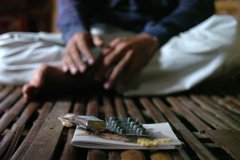
Countries in every region of the world are making
substantial progress in increasing access to HIV
treatment. Photo credit:UNAIDS/O.O'Hanlon
The report highlights a number of key areas in which efforts to scale-up services are insufficient including; the provision of antiretroviral treatment to prevent mother to child transmission of HIV (only 11% of HIV-positive pregnant women in need of treatment were receiving it in 2006); access to prevention and treatment services for people who inject drugs; and the need to scale-up testing and counselling services for people living with HIV (the report highlights that only 12% of men and 10% of women in sub-Saharan Africa know their HIV status).
The Director General of WHO, Dr Margaret Chan said, “We need ambitious national programmes, much greater global mobilization and increased accountability if we are going to succeed.”
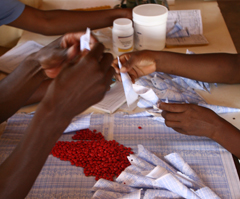
The report outlines the need to increase efforts to
accelerate the prevention, diagnosis and treatment
of HIV disease in children. Photo credit: UNAIDS/
A.Gutman
Among the recommendations outlined in the report was the need to increase efforts to accelerate the prevention, diagnosis and treatment of HIV disease in children. Although the number of children receiving treatment increased by 50% over the last year, still only 15% of those children in need of treatment had access to it.
“Children continue to be the missing face of the AIDS pandemic,” said Ann Veneman, Executive Director of UNICEF, “with too many children still missing out on life-saving treatment and access to other essential services.”
The report also gives progress on the target setting progress for universal access to prevention, treatment, care and support which UN member states committed to at the 2006 High Level Meeting on AIDS in New York. According to the report over 90 countries had set targets with 81 setting targets on treatment and 84 setting targets for at least one prevention intervention.
As a Cosponsor of UNAIDS, WHO has undertaken to monitor and evaluate the global health sector response in scaling up towards universal access and to produce annual reports. Towards universal access––scaling up priority HIV/AIDS interventions in the health sector is the first such report.
Links:
Read Press Release
Download full report (pdf 5,83 MB)
Download background document
Visit UNICEF Website
Related

Feature Story
Securing the future – advocating for children
12 April 2007
12 April 2007 12 April 2007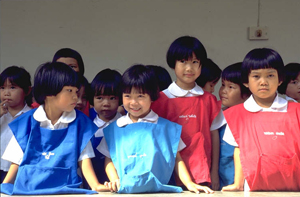
According to latest estimations, every day there are nearly 1,800
new HIV infections and 1,400 deaths of AIDS-related illnesses
amongst children under 15. Photo credit: UNAIDS/S.Noorani.
Across the world, significant progress is being made in the response to AIDS – political and financial commitment is higher than ever before and in more and more countries effective HIV prevention and treatment programmes are being made more widely available.
But all too often, children are still missing out. Despite the beginnings of progress, children still remain largely absent from national and international political responses to the AIDS pandemic.
According to latest estimations, every day there are nearly 1,800 new HIV infections in children under 15 and more than 6,000 young people aged 15–24 are newly infected with HIV. And every day 1,400 children under 15 die of AIDS-related illnesses.
In response to the urgent need to step up action for children and young people, the UNAIDS Secretariat and cosponsor UNICEF recently joined a group of 40 advocates and activists representing national and global organizations, campaigns, networks, and coalitions in Brussels, Belgium, to define a platform for joint advocacy towards the goal of achieving the first-ever “AIDS Free Generation”. Bringing together perspectives from around the world—and from the grassroots to the global arena—the group shared a deep concern that the lives, rights, and potential of millions of the world’s children are being severely eroded by the devastating impact of HIV.
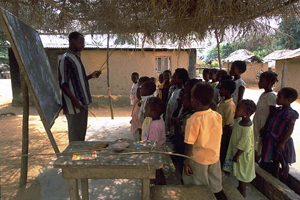
Access to free, safe, comprehensive and quality basic education
for all children will be key to moving towards an "AIDS-free
generation". Photo credit: UNAIDS/L.Taylor
Over the course of three days, the group worked together to define a framework for political change and mobilization for the interests of children in a world living with HIV. Education, HIV prevention, treatment, social protection and financing were identified as five necessary components of the platform for effective advocacy around children and HIV.
On education, the group outlined the need to advocate for access to free, safe, comprehensive and quality basic education for all children, paying particular attention to the needs of girls, and ensuring that schools can play an effective role in HIV prevention and the protection and care of children in AIDS-affected societies.
To prevent new infections among young people and children, the group stressed the urgent and rapid need to advocate for the increase of youth and child-specific HIV prevention programmes, with a focus on ensuring access to comprehensive sexual education, empowering girls, and promoting gender equality.

Advocacy will be key to help ensure that funds are utilized
effectively to reach the children and young people most in need.
Photo credit: UNAIDS/L.Alyanak.
A comprehensive, family-centered approach to care and treatment, and the provision of affordable medicines, diagnostics and health services were underlined as central to the goal of preventing HIV infection in children and ensuring treatment of all children living with HIV.
To move towards comprehensive social protection for AIDS-affected and other vulnerable children, the group stressed that advocacy should focus on preventing stigma and discrimination, providing families and communities with the resources needed to protect children’s well-being, and ensuring access to essential services and care for all orphans and vulnerable children.
For all programmes and action focused on children and young people, the group underlined the fundamental need for full and sustainable financing. Advocacy will be key to help ensure specific funding allocations within national and international development and AIDS budgets and to help ensure that funds are utilized effectively to reach the children and young people most in need.
Underlined as central to all advocacy action towards an ‘AIDS Free generation’ was the active involvement of young people themselves, to build wider alliances, and to inspire others.
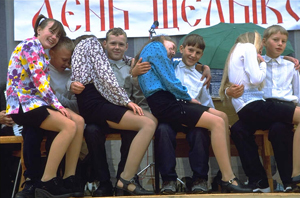
The active involvement of young people is critical for all
advocacy action towards an ‘AIDS Free generation’.
Photo credit: UNAIDS/L.Taylor
“Participants in the Summit were engaged, energized, and excited to advocate for an AIDS Free generation,” said Jennifer Delaney, Executive Director of the Global Action for Children. “This was the first step in engaging advocates, governments, the public sector and civil society in realizing this critical goal."
The advocacy group is now developing a cohesive strategy on the five main action areas, which forms the basis for a social movement to better support children affected by HIV. The strategy will include political actions which can be implemented at the national, regional and international levels.
“We are all committed to work with urgency, courage and determination to transform these goals into a new reality for and with children and young people. Future generations must be free of AIDS and spared of its devastating impacts,” said UNAIDS Director of Communication and External Relations, As Sy.
Links:
Download - Children and AIDS: Stocktaking report (2Mb, pdf)
Visit "Unite for Children, Unite against AIDS" Web site

Feature Story
AIDS events continue at World Cricket Cup
03 April 2007
03 April 2007 03 April 2007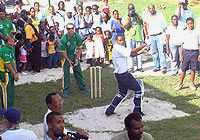
South African cricket team fielding coach
Jonty Rhodes (left) and wicketkeeper AB de
Villiers (centre) watch a young cricketer hit.
The cricket team visited the Dorothy Bailey
Health Centre in Georgetown, Guyana.
Phot credit:UNICEF/Wilson
“Every wicket counts in cricket, and it’s the same with the fight against AIDS - everybody’s contribution makes a difference.” These were the words of the UNAIDS Country Coordinator for Guyana and Suriname, Dr. Ruben del Prado, speaking during a visit by members of the South African cricket team to the Dorothy Bailey Youth Health Centre in Georgetown, Guyana.
After their close victory over Sri Lanka in the Super 8 stage of the ICC Cricket World Cup 2007, the South African team decided to take some time off and show their support for the health centre and its initiatives for young people living with HIV, the first of its kind in Guyana.
Using teamwork to defeat AIDS
Led by Minister of Health Dr. Leslie Ramsammy, UNICEF Guyana Representative Johannes Wedenig and Dr. del Prado, the cricket team was escorted into a crowded hall full of schoolchildren and other guests. Under banners calling people to “Unite for Children, Unite against AIDS”, two local schoolchildren, Murisa and Darren, welcomed everyone and spoke of the need to fight against the spread of the HIV.
Dr. Ramsammy told the assembly that HIV and AIDS was a global problem. “We are all in this together and AIDS can only be beaten if we work as a team,” he remarked.
Mr. Wedenig said it was heartening to see the peoples of South Africa and Guyana joining hands in a common cause. “Knowledge is power,” said Mr. Wedenig. “By empowering children with knowledge to protect themselves, we can win.”
Speaking on behalf of the South African cricketers, the team’s fielding coach, Jonty Rhodes, said that as well-known sportsmen they had the opportunity to highlight global challenges facing society. “ South Africa has a high prevalence of HIV,” he said, and the national cricket team is “committed to doing all we can to raise awareness about HIV, and fight the stigma and discrimination that surround it”.
Through an informal question and answer session with the participating young people and media, the world-famous right-handed batsman reiterated the importance of knowledge, teamwork and endurance in order to successfully fight HIV; similar to the skills needed for winning a cricket match.
Realizing dreams
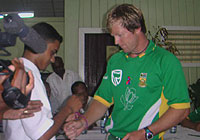
Saud, a Guyanese student, ties a Band of
Commitment on the wrist of Jonty Rhodes,
the South African cricket team’s fielding
coach at the Dorothy Bailey Health Centre
in Georgetown, Guyana.
Phot credit:UNICEF/Wilson
In a solemn moment, Mr. Rhodes and a Guyanese student, Saud, tied Bands of Commitment on each other’s wrists, as all present pledged to protect themselves and each other against HIV.
South African star bowler, Shaun Pollock, spoke of his three-year-old daughter, “She has dreams just like other kids,” he said. “I need to make sure that she can realize her dreams.”
After the formal ceremony, the visitors toured Dorothy Bailey Health Centre before everyone went outside to play cricket. On a bumpy grass-and-sand wicket next to the centre, Mr. Pollock lobbed soft balls to Minister of Health Dr. Ramsammy, who played a secure, straight bat before being caught in the slips.
The event was one of many taking place across the region on the occasion of the World Cup organized by the partnership between the International Cricket Council (ICC), UNICEF, UNAIIDS and the Caribbean Broadcast Media Partnership on HIV/AIDS, to highlight the situation of children and young people living with and affected by HIV.
This story first appeared on the special ICC Cricket World Cup section of the Unite for Children Unite against AIDS web site – uniteforchildren.org
Links:
Read “Cricket World Cup raises AIDS awareness"
For more information on the AIDS activities around the Cricket World Cup and to access the public service announcements please visit the following links:
Special page on Cricket World Cup
International Cricket Council
Live Up Campaign
Caribbean Broadcast Media Partnership on HIV/AIDS

Feature Story
Signs of progress in global response to Children and AIDS
16 January 2007
16 January 2007 16 January 2007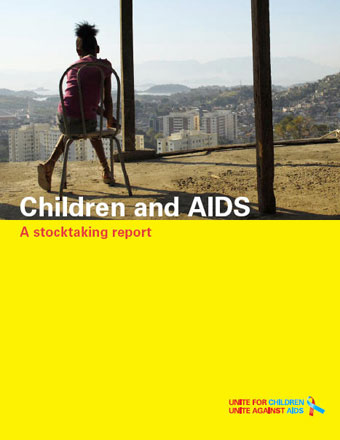
Photo credits : UNICEF
Just over a year ago, UNIC EF, UNAIDS and other partners launched Unite for Children, Unite against AIDS initiative to highlight the missing face of the child in the AIDS response.
On Tuesday, 16 th January 2007 UNICEF released the “Children and AIDS: A Stocktaking” report summarizing progress on children and AIDS since the initiative was launched in October 2005 and highlighting important breakthroughs and progress noted in the global response to Children and AIDS since the campaign launch. Such achievements include real progress noted in some countries in preventing HIV transmission from mothers to children and providing treatment for children living with AIDS.
“There is an urgent need to help children impacted by AIDS,” UNICEF Executive Director Ann M. Veneman said. “Unite for Children, Unite against AIDS is focused on ensuring treatment for HIV-positive children, prevention of mother-to-child transmission and assisting children who have been orphaned by AIDS. We must build momentum to achieve positive results for children.”
Within the UNICEF report, findings are presented on four key areas: preventing mother-to-child transmission, access to AIDS treatment, preventing new HIV infections and support to orphans and vulnerable children.
Preventing mother-to-child transmission
The stocktaking report finds that there are signs of considerable progress in the area of preventing transmission of HIV from mother to child (PMTCT). Some high-prevalence countries in Eastern and Southern Africa have shown particularly encouraging results. In Namibia for example, the percentage of HIV-infected pregnant women who received treatment for preventing HIV transmission to their infants increased from six per cent in 2004 to 29 per cent in 2005. In South Africa the percentage increased from 22 per cent in 2004 to 30 per cent in 2005.
However, despite these gains, the report details how the overall percentage of pregnant women receiving treatment for preventing transmission remains extremely low. In 2005, it was estimated that only nine per cent of pregnant women with HIV in low- and middle-income countries were receiving treatment for preventing HIV transmission to their children.
Access to AIDS treatment
The report also notes particular momentum in the provision of treatment to children living with AIDS, a result of improved testing, better health worker skills, lower drug prices and simpler formulations. Several countries – including Botswana, India, Rwanda, South Africa and Thailand – have been able to scale up HIV treatment for children by integrating it into treatment sites for adults.
Globally, still only one in ten children needing antiretroviral treatment receives it. However, prices of antiretroviral drugs for children have come down dramatically over the past 12-18 months. The report notes that in 2006, the Clinton Foundation HIV/AIDS Initiative negotiated a reduction in the cost of paediatric AIDS treatment to less than $0.16 per day, or $60 per year, helping to spur competition in the development of paediatric formulations.
Preventing new HIV infections
HIV Prevention responses are displaying renewed attention on the need to focus strategies on adolescents and young people most at risk, according to the report. The report notes that young women should be specially targeted since globally, a higher number of young women are being infected than men.
New evidence suggests that declining HIV prevalence in Kenya, urban areas of Cote d’Ivoire, Malawi and Zimbabwe, and in rural areas of Botswana, has resulted from the adoption of safer sexual behaviour by young people. In more than 70 countries surveyed, testing and use of counselling services increased from roughly 4 million people in 2001 to 16.5 million in 2005.
Supporting orphans and vulnerable children
The disparity between orphans and non-orphans in access to education is being significantly reduced in several countries, partly due to the abolition of school fees, according to the report.
The report notes that collecting and disaggregating data by age group and gender is one of the most vital, simple and effective ways of putting children on the AIDS agenda. This report uses for the first time a baseline against which new and existing data can be measured in order to identify discernible trends regarding children and AIDS.
Links:
Read Stocktaking report (2 MB, pdf)
Read 'Preventing mother to child transmission (PMTCT)' Fact Sheet (37 kb, pdf)
Read 'Providing pediatric treatment' Fact Sheet (37 kb, pdf)
Read 'Prevent infection among adolescents and young people' Fact Sheet (37 kb, pdf)
Read 'Protecting and supporting children affected by AIDS' Fact Sheet (39 kb, pdf)
Know more about "Unite for Children, Unite against AIDS" campaign (1,4 MB, pdf)
Visit "Unite for Children, Unite against AIDS" Web Site
Related

Press Release
An AIDS-Free Generation is achievable by focusing on the most disadvantaged communities affected by HIV, says a new U.N. report marking World AIDS Day
30 November 2010 30 November 2010NEW YORK, 30 November 2010 - Achieving an AIDS-free generation is possible if the international community steps up efforts to provide universal access to HIV prevention, treatment, and social protection, according to “Children and AIDS: Fifth Stocktaking Report 2010,” which was released today in New York. Attaining this goal, however, depends on reaching the most marginalized members of society.
While children in general have benefited enormously from the substantial progress made in the AIDS responses, there are millions of women and children who have fallen through the cracks due to inequities rooted in gender, economic status, geographical location, education level and social status. Lifting these barriers is crucial to universal access to knowledge, care, protection, and the prevention of mother-to-child transmission (PMTCT) for all women and children.
“To achieve an AIDS-free generation we need to do more to reach the hardest hit communities. Every day, nearly 1000 babies in sub-Sarahan Africa are infected with HIV through mother to child transmission,” said Anthony Lake, UNICEF’s Executive Director. “Our Fifth Stocktaking Report on Children and AIDS highlights innovations like the Mother Baby Pack that can bring life-saving ARV treatment to more mothers and their babies than ever before,” said Lake.
The World Health Organization (WHO) revised its guidelines earlier this year, to ensure quality PMTCT services for HIV-positive pregnant women and their infants. In low- and middle-income countries, 53 per cent of pregnant women living with HIV received antiretrovirals (ARVs) to prevent mother-to-child transmission in 2009, compared to 45 per cent in 2008. One of the most significant increases occurred in Eastern and Southern Africa, where the proportion jumped ten percentage points, from 58 in 2008 to 68 per cent in 2009.
“We have strong evidence that elimination of mother-to-child transmission is achievable," said Dr Margaret Chan, WHO’s Director-General. “Achieving the goal will require much better prevention among women and mothers in the first place.”
AIDS is still one of the leading causes of death among women of reproductive age globally and a major cause of maternal mortality in countries with generalized epidemics. In sub-Saharan Africa, 9 per cent of maternal mortality is attributable to HIV and AIDS.
“Around 370,000 children are born with HIV each year. Each one of these infections is preventable,” said Michel Sidibé, Executive Director, UNAIDS. “We have to stop mothers from dying and babies from becoming infected with HIV. That is why I have called for the virtual elimination of mother to child transmission by 2015.”
WHO also issued new ARV guidelines for treating infants and children, paving the way for many more children with HIV to be eligible for immediate antiretroviral treatment (ART).
In low and middle-income countries, the number of children under the age of 15 who received treatment rose from 275,300 in 2008 to 356,400 in 2009. This increase means that 28 per cent of the 1.27 million children estimated to be in need of ART receive it.
Infants are particularly vulnerable to the effects of HIV, which has lent an urgency to the global campaign for early infant diagnosis. While the availability of early infant diagnosis services has increased dramatically in many countries, global coverage still remains low, at only 6 per cent in 2009. Without treatment, about half of the infants infected with HIV die before their second birthday.
In most parts of the world, new HIV infections are steadily falling or stabilizing. In 2001, an estimated 5.7 million young people aged 15–24 were living with HIV. At the end of 2009, that number fell to 5 million. However, in nine countries – all of them in southern Africa – at least 1 in 20 young people is living with HIV.
Young women still shoulder the greater burden of infection, and in many countries women face their greatest risk of infection before age 25. Worldwide, more than 60 per cent of all young people living with HIV are female. In sub-Saharan Africa, that figure is nearly 70 per cent.
“We need to address gender inequalities, including those that place women and girls at disproportionate risk to HIV and other adverse sexual and reproductive health outcomes” said Irina Bokova, Director General of UNESCO. “While we are encouraged by a decline in HIV incidence among young people of more than 25 per cent in 15 key countries in sub-Saharan Africa between 2001 and 2009, we must do everything possible to sustain and increase such positive trends in order to achieve Universal Access to prevention, treatment, care and support.”
Adolescents are still becoming infected with HIV because they have neither the knowledge nor the access to services to protect themselves. Attaining an AIDS-free generation means erasing the inequities that fuel the epidemic and protecting those who continue to fall through the cracks. Social protection initiatives – including cash transfers and efforts to promote access to services – play an important role in breaking the cycle of vulnerability. The report also emphasizes the importance of tailoring education programmes to target the most vulnerable youths – those who are out of school – with information about HIV prevention.
"We must increase investments in young people’s education and health, including sexual and reproductive health, to prevent HIV infections and advance social protection," said Thoraya Ahmed Obaid, Executive Director of UNFPA, the United Nations Population Fund. “Reaching marginalized young people, including vulnerable adolescent girls and those who are not in school, must remain a priority"
Publications

Press Release
UNICEF: Young of Central Asia and Eastern Europe Suffering Blame and Banishment
19 July 2010 19 July 2010VIENNA, 19 July 2010 - An underground HIV epidemic in Eastern Europe and Central Asia is intensifying at an alarming pace, fueled by drug use, high-risk sexual behavior and high levels of social stigma that discourage people from seeking prevention information and treatment, according to a new report released today by UNICEF.
The report, “Blame and Banishment: The underground HIV epidemic affecting children in Eastern Europe and Central Asia,” highlights the issues faced by children living with HIV, adolescents engaged in risky behaviors, pregnant women using drugs, and the more than one million children and young people who live or work on the streets of the region.
Marginalized young people are exposed on a daily basis to multiple risks, including drug use, commercial sex and other exploitation and abuse, putting them at higher risk of contracting HIV. The trends are especially troubling, as the region is home to 3.7 million injecting drug users – almost a quarter of the world total. For many, initiation into drug use begins in adolescence.
Existing health and social welfare services are not tailored to adolescents at greatest risk, who are often exposed to moral judgment, recrimination and even criminal prosecution when they seek treatment and information on HIV.
“Children and adolescents living on the margins of society need access to health and social welfare services, not a harsh dose of disapproval,” said Anthony Lake, UNICEF’s Executive Director.
To reach and help young people living with HIV or at risk of HIV infection, medical and civil authorities need to establish non-judgmental, friendly services that address the special needs of marginalized adolescents.
In the Russian Federation, for example, over 100 youth-friendly service facilities have been established, providing reproductive and sexual health services, information, counseling and psychological support. The Atis health center in Moldova is another initiative that is showing promise and saving lives.
“We cannot break the trajectory of the AIDS epidemic in eastern Europe and Central Asia without empowering and protecting children and adolescents,” said Michel Sidibé, Executive Director of UNAIDS. “We must not rob them of their childhood.”
“It is our responsibility to ensure that they have access to HIV prevention and treatment services.”
An HIV prevention and treatment center in Tajikistan is breaking down barriers of mistrust to reach adolescent girls selling sex. As one young client said, “In the beginning, I did not believe that the medical check-up, the treatment and condoms would really be free of charge and anonymous. I thought it was another trap by the police. I agreed to go there with an outreach worker for the first time, but now I go there alone and encourage my friends to use the service as well.”
A recent six-country UNDP study conducted in the region showed that many adults living with HIV fear the social stigma attached to seeking treatment more than they fear the disease, thus driving the epidemic further underground.
The stigma associated with HIV is not restricted to adults and adolescents. Young children living with HIV are routinely denied access to school and kindergartens, and when their status is known, they face rejection and abuse. Alla, the foster mother of an HIV-positive child, tells how her son was ostracized when someone leaked his HIV status to other families. “His classmates say that he is ‘disgusting’ and refuse to play with him,” she said.
“This report is a call to protect the rights and dignity of all people living with or at risk of exposure to HIV, but especially vulnerable children and young people. We need to build an environment of trust and care, not one of judgment and exclusion,” said Lake. “Only by reversing discrimination against people living with HIV, can Eastern Europe and Central Asia begin to reverse the spread of the epidemic.”
Right Hand content
Press centre:
Download the printable version (pdf, 128 Kb)
Contact:
UNICEF New York
Kate Donovan
+43 699 195 405 08
+1 917 378 2128
kdonovan@unicef.org
UNICEF Kyiv
Veronika Vashchenko
+ 43 699 181 496 93
vashchenko@unicef.org
UNICEF Geneva
John Budd
+ 41 22 909 5429
jbudd@unicef.org
Publications:
UNAIDS Outlook Report 2010 (pdf, 6 Mb)
UNAIDS Outcome Framework 2009-2011 (pdf, 388 Kb)

Press Statement
UNAIDS welcomes appointment of new UNICEF Executive Director
17 March 2010 17 March 2010Geneva, 17 March, 2010 — The Joint United Nations Programme on HIV/AIDS (UNAIDS) welcomes the appointment of Mr Anthony Lake as Executive Director of the United Nations Children’s Fund (UNICEF).
Mr. Lake was national security advisor to former U.S. President Bill Clinton and has had a long and highly respected career in the U.S. Government. He is currently a Distinguished Professor at Georgetown University. In addition, he has served on the Board of the US Fund for UNICEF and will start his new position on 1 May, 2010.
“I look forward to working closely with Mr Lake on our shared goals of ensuring countries reach their universal access goals for children and adolescents in HIV prevention, treatment, care and support,” said Mr Michel Sidibé, Executive Director of UNAIDS. “And a big part of this will be working together to eliminate mother-to-child transmission of HIV.”
UNAIDS also thanks the leadership and contributions of outgoing UNICEF Executive Director Ms Ann M.Veneman.
UNICEF is a Cosponsor of UNAIDS and has been a leading organization for children, working in 158 countries to help children survive and thrive, from early childhood through adolescence. The organization focuses its HIV response on four priority areas: prevention of mother-to-child transmission of HIV; paediatric HIV care and treatment; protection, care and support for children affected by AIDS; and HIV prevention among adolescents and young people.
UNAIDS welcomes appointment of new UNICEF Executi
Press centre:
Download printable version (pdf, 28 Kb)
Contact:
UNAIDS Geneva
Saya Oka
tel. +41 22 791 1697
okas@unaids.org

Press Release
UNICEF’s State of The World’s Children report commemorates 20 years of the Convention on the Rights of the Child
18 November 2009 18 November 2009NEW YORK, 19 November 2009 – A special edition issue of UNICEF's flagship The State of the World's Children report, tracking the impact of the Convention on the Rights of the Child and the challenges that remain, was released today on the eve of the 20th anniversary of the Convention’s adoption by the UN General Assembly.
“The Convention on the Rights of the Child is the most ratified human rights treaty in human history,” said UNICEF Executive Director Ann M. Veneman. “It has transformed the way children are viewed and treated throughout the world.”
The Convention has 193 ratifications, the process by which countries decide to be bound by the articles of an international treaty. It articulates a set of universal children’s rights, such as the right to an identity, a name and a nationality, the right to an education, and rights to the highest possible standards of health and protection from abuse and exploitation.
These rights are based on four core principles – non-discrimination; the best interest of the child as primary consideration in matters that affect them; rights to life, survival and development, and respect for the views of children.
The Convention also identifies the obligation of governments to do all they can to deliver these rights, and acknowledges the special role of parents in their children’s upbringing.
The State of the World’s Children report describes the timeless relevance of the Convention.
More than seventy countries have incorporated children’s codes into national legislation based on the Convention’s provisions, and awareness and advocacy on child protection issues have increased markedly since the Convention was opened for signature 20 years ago.
Considerable progress has been made through the past twenty years:
- The annual number of deaths of children under five years of age has fallen from around 12.5 million in 1990 to an estimated 8.8 million in 2008, representing a 28 per cent decline in the rate of under five mortality;
- Between 1990 and 2006, 1.6 billion people world-wide gained access to improved water sources;
- Globally, around 84 per cent of primary-school-age children are in class today and the gender gap in primary school enrolment is narrowing;
- Children are no longer the missing face of the HIV and AIDS pandemic;
- Important steps have been taken to help protect children from serving as soldiers or trafficked into prostitution or domestic servitude; and
- The age of children getting married is rising in some countries and the number of girls subjected to genital cutting is gradually falling.
But children’s rights are still far from assured, according to UNICEF.
“It is unacceptable that children are still dying from preventable causes, like pneumonia, malaria, measles and malnutrition,” said Veneman. “Many of the world’s children will never see the inside of a school room, and millions lack protection against violence, abuse, exploitation, discrimination and neglect.”
The rights of girls still require special attention. The majority of children who do not attend primary school are girls, and girls are more likely to suffer sexual violence, to be trafficked or to be forced into child marriage. In many regions they are less likely to receive essential healthcare.
The report includes special expert essays from public and private sector representatives, alongside examples of the child rights situation in a range of countries.
Many of the expert essays offer advice on the role the Convention can have, in an increasingly populous, urbanized and environmentally challenged world, over the next 20 years and beyond. The report also provides a range of suggestions that could ensure the protection of children’s rights continues to advance.
More than 160 events are taking place worldwide commemorating the 20th anniversary of the Convention. The special edition of The State of the World’s Children is part of UNICEF’s contribution to those commemorations, which also includes jointly hosting, with civil society and government partners, a global commemoration and panel discussion to be held at the United Nations Headquarters on the 20th of November.
“The big challenge of the next 20 years is to firmly position the best interests of children at the heart of all human activity,” said Veneman. “It is our collective responsibility to ensure every child’s rights to survival, development, protection and participation."
About UNICEF
UNICEF is on the ground in over 150 countries and territories to help children survive and thrive, from early childhood through adolescence. The world’s largest provider of vaccines for developing countries, UNICEF supports child health and nutrition, good water and sanitation, quality basic education for all boys and girls, and the protection of children from violence, exploitation, and AIDS. UNICEF is funded entirely by the voluntary contributions of individuals, businesses, foundations and governments.
Attention editors and broadcasters: Multi media packages including photos and b-roll will be available starting from 16th of November at www.thenewsmarket.com/unicef
For further information, embargoed copy of the report, interviews with experts, please contact:
Rebecca Fordham, UNICEF Media, 1 212 326 7162,
rfordham@unicef.org
Kate Donovan, UNICEF Media, 1 212 326 7452,
kdonovan@unicef.org
UNICEF’s State of The World’s Children report com
Press centre:
Contact:
UNAIDS: Sophie Barton-Knott
Tel. +41 22 791 1697
E-mail: bartonknotts@unaids.org

